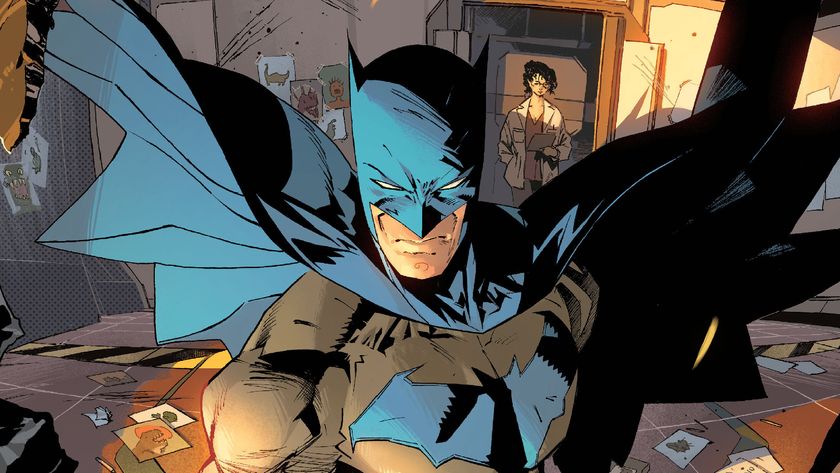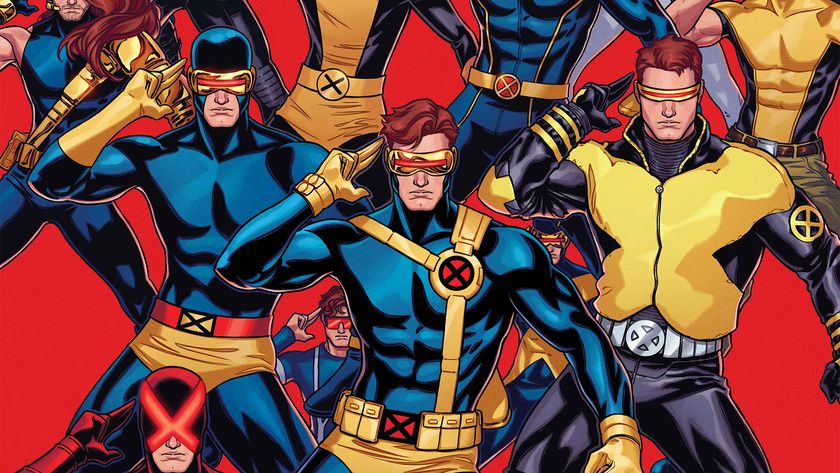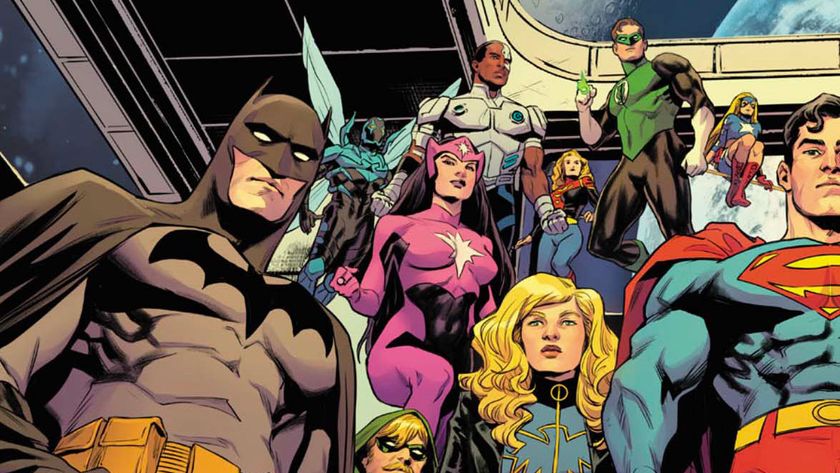The McElroys explore the Adventure Zone deeper than ever before with Petals to the Metal
Drawn by Carey Pietsch, and published by First Second
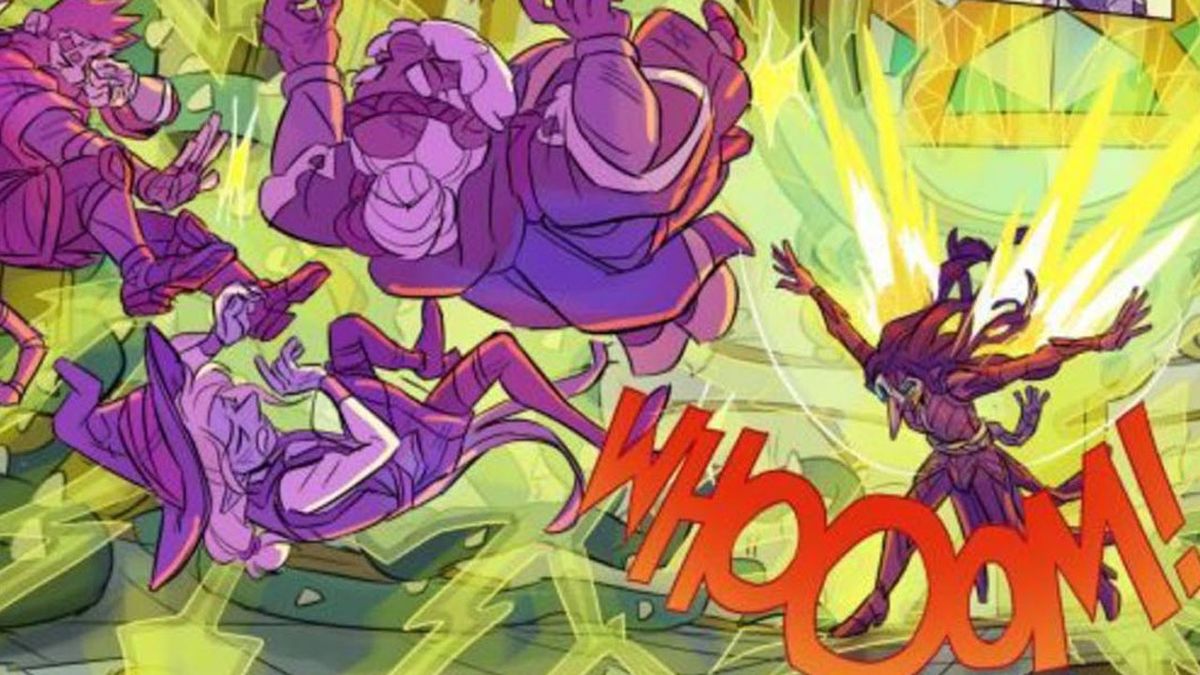
Get ready to push it past the redline in the latest installment of The Adventure Zone original graphic novels: Petals to the Metal! Based on the hit Maximum Fun podcast of the same name and published by First Second, Petals to the Metal follows Taako, Merle, and Magnus on assignment to the glamorous, gilded metropolis of Goldcliff in pursuit of another powerful artifact. In short order, they find themselves swept up in the do-or-die world of illegal battle wagon racing - can Tres Horny Boys survive the highway to the danger zone, or are they destined to crash and burn?
Hosted by brothers Justin, Travis, and Griffin McElroy, along with their dad Clint, The Adventure Zone's debut episode Balance swiftly became a fan-favorite after its debut as a spin-off of the brothers' advice show My Brother, My Brother, and Me in 2014. Both prior volumes of the series, Here There Be Gerblins and Murder on the Rockport Limited - both illustrated by co-adapter Carey Pietsch, with letters by Tess Stone - both became New York Times bestsellers.
Petals to the Metal marks both the original series' and the podcast's biggest foray into the wider world of The Adventure Zone, and the Petals to the Metal OGN offers a fresh approach to the arc that will have new fans instantly hooked and give longtime listeners even more to appreciate. In advance of the graphic novel's July 14 debut, Newsarama had the opportunity to speak with Justin and Clint McElroy along with Carey Pietsch about what readers can expect to encounter at the starting line!
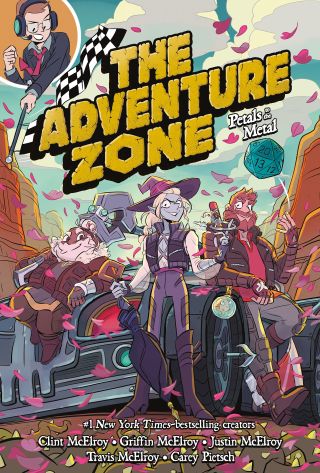
Newsarama: This is your third graphic novel which obviously you know very well. But what is it like to be getting ready for that especially as two New York Times bestsellers?
Justin McElroy: Nowhere to go but down, C.K. When you're number one, there's only one number next to that and that's number two. And that's the fear is that we won't be able to deliver. The overriding thing is just that panic of having peaked before I'm even 40. In Dad's case, he's been - you know, he's in his twilight years, so a peak in your very late 70s like Dad makes sense, but that's where I'm at currently.
Clint McElroy: And I'm more pessimistic. I think zero is the next thing for us to achieve so that's the next number for us. So, maybe they'll just make the whole list out of us. I don't know.
Carey Pietsch: I feel like this is our first time having graphic novels come out with the actual comic bestseller list back in existence, with the New York Times comic list back in existence. But Clint, you're projecting that the book is going to have such poor reception that they're going to take it away again?
Comic deals, prizes and latest news
Get the best comic news, insights, opinions, analysis and more!
Clint McElroy: I think they're just going to name the whole category after us. I think that's how good it's going to be.
Justin McElroy: They may cancel comics, there may be an announcement: comics were a mistake.
Carey Pietsch: Listen.
Justin McElroy: We're not doing them anymore.
Carey Pietsch: It's long overdue.
Clint McElroy: That could either be thanks to us or in spite of us.
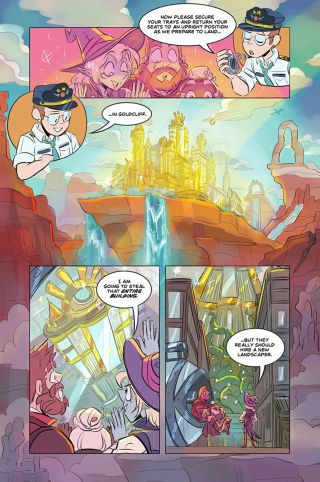
Nrama: From Gerblins to Rockport and now to Petals to the Metal, has it gotten any easier at all? Or has it gotten more difficult, this sort of adaptation or editorial process as you get deeper into the larger world of The Adventure Zone: Balance?
Clint McElroy: I think that we've had to make a few more foundational decisions. Especially in the outline phase, because it has become more narrative-driven than character-driven. I mean, let's face it, Gerblins, we were just being goons. And as the overall arc and story became more important and more important, we toned down the goonery and put more emphasis into the actual overall story.
Carey Pietsch: And I think that's definitely been a challenge, right? Not just from the standpoint of projecting forward to theoretical future books, but also kind of establishing the kind of visual mechanics and motifs that we know if we make it that far in the series, we're going to have to come back to. Things like the Hunger and what the Red Robes look like and how they act. Which is definitely a challenge.
But I also feel really lucky that we've gotten to make...I was going to say "so many," and three does feel like so many books to me. Because it can kind of build on this established language of the way the characters do interact with each other and the world, not just in terms of kind of being able to use the shorthand for how they feel about each other but in terms of being able to hopefully surprise you when that sort of thing shifts.
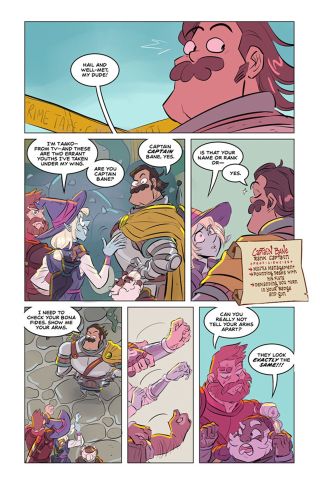
Nrama: And in that vein, Petals to the Metal marks sort of the biggest departure from the podcast so far, at least the narrative of the podcast. Could all of you talk a little bit about some of the changes you decided to make for Petals to the Metal?
Clint McElroy: Well, one of the things that we knew we wanted to do when we went into the graphic novels is try to expand the characters outside of the main three, to really kind of flesh out this world and tell more of their stories.
So I think it just became natural that we would do more with Hurley and Sloane, try to enrich their back story and that way have a little bit more emotional impact when their story is told. And I think that really kind of stepped up to the front of the storytelling with Petals.
Carey Pietsch: Yeah. I feel really lucky that we ended up with so much space to give their relationship in particular to grow and breathe on the page, and some of that is through text and a lot of it is also, again, through the kind of background or visual information that you can provide with comics. So in body language, in the way they act around each other. There's some new Garyl material that I'm also really excited about. Hurley and Sloane are two of my favorite NPCs and I really love what we got to do with them here.
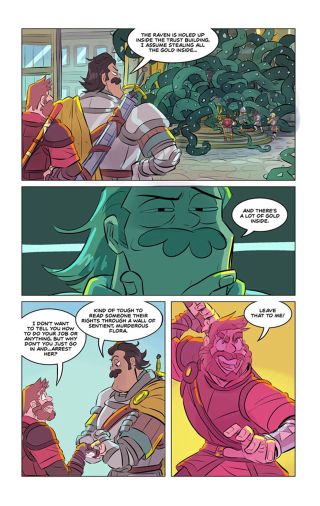
Nrama: I wanted to ask about Garyl, actually. Just from other artist friends of mine or artists that I've followed for a while, it seems like a Fast and the Furious/Death Race car sequence culminating in the appearance of a horse, that everybody's just been waiting to see on the page is the "challenging art decision BINGO" situation.
What was the most challenging thing for you, Carey, in Petals? Either about the battle wagon race or anything else that got added? And what was your favorite thing to tackle on the page this time?
Carey Pietsch: Wow, C.K., I feel like the "challenging art BINGO" is an excellent way to put the...the prospect of the fifty-page race, with not just cars but also horses and bicycles is really, really intimidating. But I feel so lucky that the whole team was on board for me coming to everybody to say, listen, you've already established that these are battle wagons and not cars. But what if we just lean all the way into it and make them into these weird, cartoon animals shapes instead of anything remotely resembling a car?
And I feel like I stand by that, both because you have to do a little bit less work to convince people that a battle wagon is really a battle wagon, than you do to have to convince them that a car you've drawn is really a car. You're not working against the same accumulated weight of knowledge of what a car looks like. So that was definitely a big help to make it less terrifying of a prospect to have to draw this whole thing.
I think that sequence ended up being one of my favorites in the book because of how it came together. There's a lot of bits from the original podcast that I think were preserved really well in the script. So a mix between the high octane Speed Racer car chase and the high shoujo dramatic emotional moments of the climax and epilogue are my real favorite parts.
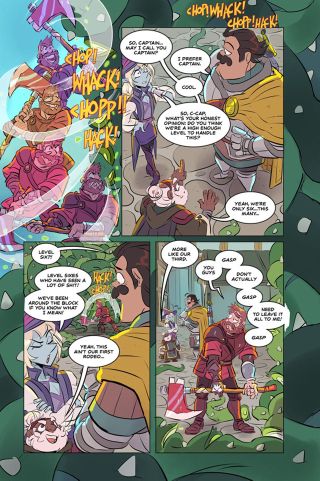
Nrama: For all of you, and this one's pretty easy, I would just like to know what your favorite battle wagon was of all the designs for Petals, what was your favorite battle wagon to get to see come to life?
Justin McElroy: This is where I have to be embarrassed by my own lack of knowledge about our own stuff but you know the big one, the big round glass full of water?
Nrama: Yeah, the octopus!
Justin McElroy: Yeah, yeah, yeah, that is my favorite. It's an octopus, that's exactly what I meant to say, yeah.
Nrama: When I edit this I'm just going to attribute that to you.
Justin McElroy: Perfect.
Nrama: Clint, what about you? What was your favorite battle wagon?
Clint McElroy: I love the octopus one too but I like the wild boar and the chariot kind of thing, just because I mean, the whole scene is reminiscent of Ben Hur on steroids. So, I love that kind of one-on-one, being the solo unit in battle. In glorious, glorious battle!
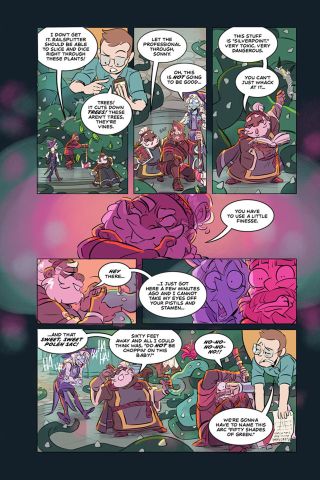
Carey Pietsch: I will say, I'm cheating because I literally had to flip open the copy of the book that I have at my desk and look back through the race to be like, what? What did I draw? What cars are in here?
I really like Sloane's Raven wagon with the dramatic wing extension towards the climax. I drew the Ram wagon so often that it probably is the one that I had the easiest time drawing by the end, by sheer force of will and strength of numbers. So maybe a tie between the two of them.
Nrama: Going back to the narrative structure, how do all of you weigh the changes that you decide to make in the adaptation process, whether it's the decision to add more narrative stuff, going a little bit more into Hurley and Sloane's backstories, or just structural stuff like, well we have this giant extremely long car race, what do we do with that?
Clint McElroy: I think we knew right off the bat that the race was going to be the focal point, the main thing in the book. So we didn't really worry that much about it. It was more along the lines of, what do we do with the rest of the story? We knew the battle wagon race was going to be amazing, because of what Carey does with it, and the fact that when we did it on the podcast, I can remember, it was one of the most exciting things I've ever been a part of.
I mean, even though it was just audio, I think that was one of the first times where we said, wow this would sure make a good movie or a good graphic novel or something like that because the action is very fast-paced, unrelenting and I think we knew that was going to be a big part of the story. So the narrative decisions we had to make, the editorial decisions we had to make were how to get there and how to get there in a way so that it would have maximum emotional impact, not just be a great action scene.
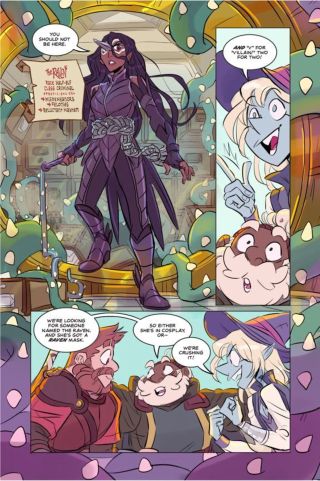
Nrama: How do you decide what jokes from the podcast work in the comic? How do you decide what to change or what to change it to? Is it just like 'well, this works better in audio versus visual' or are there other decisions involved in that?
Clint McElroy: It's kind of nice the way we've got the writing side set up in the fact that I'm kind of the throw everything against the wall guy. And then Justin, Travis, and Griffin are the, 'nah peel that off the wall', guys. We really worked very hard on the joke placement, the joke construction and whether or not the joke will work.
A lot of jokes are just audio jokes, but what's beautiful about our relationship with Carey and where we've come in this process is, there are a lot of times where we'll say, yeah, we can't do that audio joke, there's no way to get that across because you can't get across timing and you can't get across delivery, but Carey would say let me see if I can make it work, and almost every time she says, let me see if I can make that work, it worked. So we were able to keep a higher portion of straight audio jokes in there than we thought we would.
Carey Pietsch: I feel really lucky that we work with Tess Stone, our letterer on the book. And he is a brilliant cartoonist and also just such a fantastic job making the lettering, especially his hand type and his sound effects really sing. I feel like that's a good way that comics can kind of try to convey some of the tone of voice that might otherwise be lost translating from audio to visual.
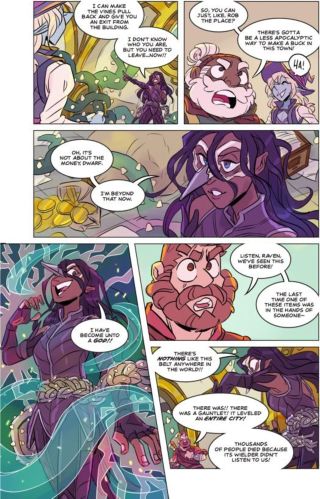
Nrama: In terms of jokes, I think that I wouldn't have expected to work from the show to a visual adaptation, the cut away from Hurley's garage to the Hammerheads is really impeccable, that's impeccable comedic timing on the page.
Carey Pietsch: I'm so glad to hear that worked, I think we all talked a lot about how to translate...like obviously, some of the Hammerhead garage stuff got compressed down, but I think that particular cut is a great example of a way that the book makes a cut in order to preserve the tone of that scene, right? Like we don't have... I'm only mortal, I can't draw 60 pages of the lead up to the Hammerhead garage, but we're trying to capture the way it feels to listen to that stretch of the podcast in comic form.
Justin McElroy: Hammerhead garage is interesting because you're really seeing there for one of the first times, I think--not one of the first times, we've dealt with this before. Dungeons & Dragons is often defined by sort of wanton destruction and death, and we made a joke of it in the podcast. There is something trickier about nailing the tone of that when you have to actually see the terrible things that you're doing.
I think it'd be easier to say, he does a terrible thing! And you can move on and do the joke. I think it is a little tougher to actually, visually see this terrible thing happening. So, Carey really had to thread quite the needle with that to make it still seem like playful, squishing a guy with a car jack, you know, like, fun!
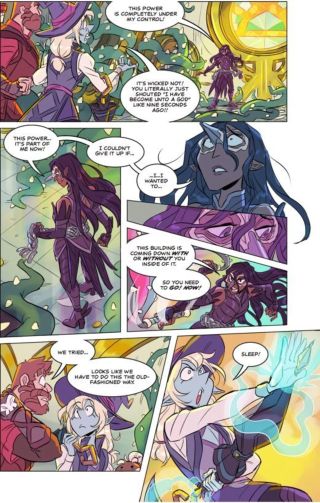
Nrama: Speaking of, I guess, terrible things in a different perspective, Merle talking his way into the bank is probably one of the most iconic scenes of at least the Petals to the Metal arc. And I know that was one of the first scenes that got previewed.
Justin McElroy: I'm sorry, did you say iconic or worst?
Nrama: I think both of those things can be true at the same time for different reasons. And I think this is one of the rare cases where it is. What was it like to decide how to bring that scene to life? Because that seems like a really interesting set of circumstances to have put into a podcast in the first place and also to relive, to publish in a major graphic novel.
Clint McElroy: I think what saved the scene in the graphic novel was Carey's beautiful rendition of Magnus and Taako's reactions. Their reactions, their facial expressions reacting to what was going on, for me made it hilarious, the way they were...well, the way Justin just reacted a few minutes ago. I think that's what made it, I think it made it even funnier and I think that was, for me that was the joy of it because it was, basically when it happened originally in the podcast it was just to irritate my children.
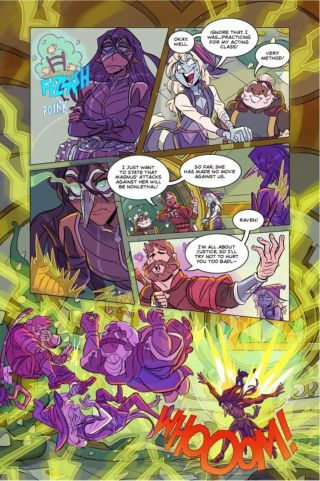
Nrama: And as a Taako fan, I have to ask, whose decision was it to add in the Daddy Alert joke? I'm just really curious.
Justin McElroy: That feels like an Ali [Wilgus, the series' editor] addition but I don't know.
Carey Pietsch: Uh...hmm. I think that was Griffin, actually.
Justin McElroy: Yeah, there you go.
Nrama: It just inserted itself, apropos of nothing. Which I mean, that seems like that would track as well.
[Editor's note: In pursuit of the full truth behind the appearance of this line, we reached out to series editor Ali Wilgus through First Second for an editorial clarification on its origins. Wilgus said, "That particular exchange between Taako and Merle was 100% Griffin's idea -- he came up with it while solving a different revision problem, and I'm very glad he did, because it's hilarious."]
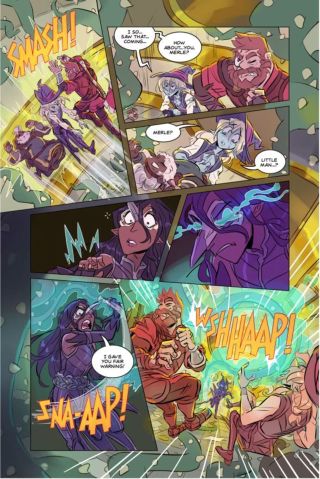
Nrama: What are all of you most looking forward to people getting to experience in Petals to the Metal? Whether that's something that was added or just something that you think translated really well from the show to the graphic novel?
Justin McElroy: I think the relationship between Sloane and Hurley is such an important moment for The Adventure Zone in general. And I think there must be some people who are just reading the graphic novels and haven't listened to the podcast but either way, I think seeing the turn that it makes for the ability to tell that kind of story, and make it more emotional or heartfelt. I think it's a really important moment. I think Carey carried it across beautifully so I'm excited for people to see that.
Clint McElroy: I think in tying in with that, I think the ending, which of course involves both of those two characters extensively but kind of the way that we wrapped it up and kind of the way that the book ended, I was very proud of that. I was very proud of what happens at the end of the book and I'm really excited to see what people think about that.
Carey Pietsch: I have to cheat and kind of piggyback off of both Justin and Clint's very kind answers and just the entire final third of the book which encompasses the race and obviously the ending and kind of a lot of really good shoujo, high energy, high emotional resolution, things that I'm really excited for people to get to read.
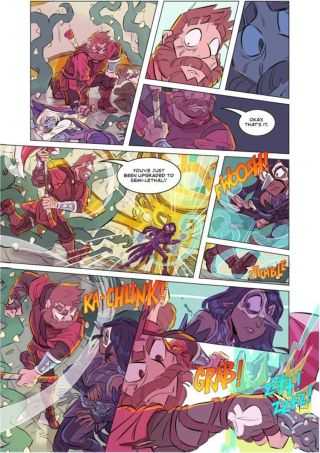
Nrama: And then I'm going to sneak in one last kind of out of nowhere question, Carey, I like the way you illustrate Griffin in each one. It's really cute firstly but also I love the Rockport look with the conductor's uniform. What inspired Griffin's race announcer look? Because, and this is sort of a weird reference, but he has a really powerful young Jim Cornette, the wrestling commentator, energy? It was such a specific vibe that it really struck me in this one.
Carey Pietsch: Oh man, i wish I were cool enough to know what wrestling commentator you were talking about but I absolutely don't.
Clint McElroy: Well I am uncool enough to get that reference and I can remember us talking about it, and making a conscious decision because the action of the race was going to be so big and so energetic that Griffin needed to be so big and energetic in it, too. So I'd like to really make it sound like we're geniuses and we knew that was the plan, but the only thing I can remember is at one point thinking, 'well, you know he needs to be more of a Howard Cosell than a Curt Gowdy so that he kind of stands out as his own personality'.
Nrama: It was so good!
Carey Pietsch: There ya go, totally true.
Most Popular




